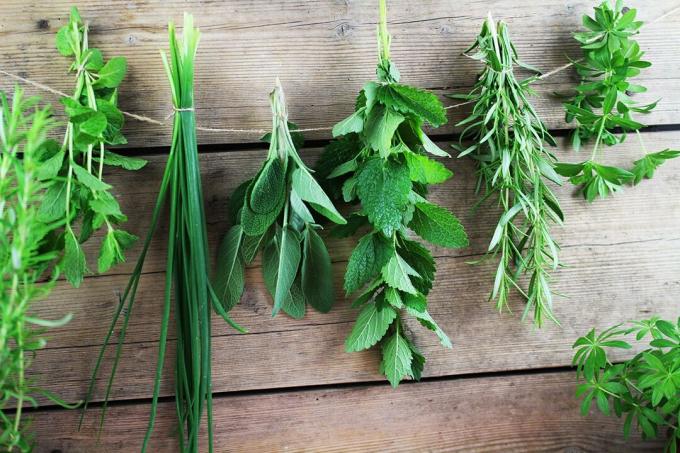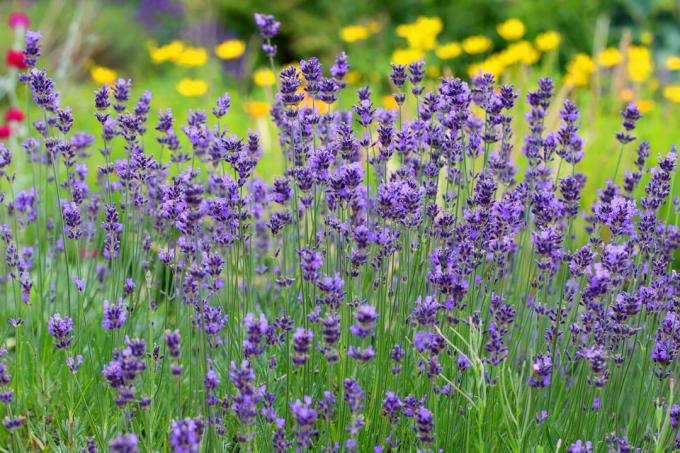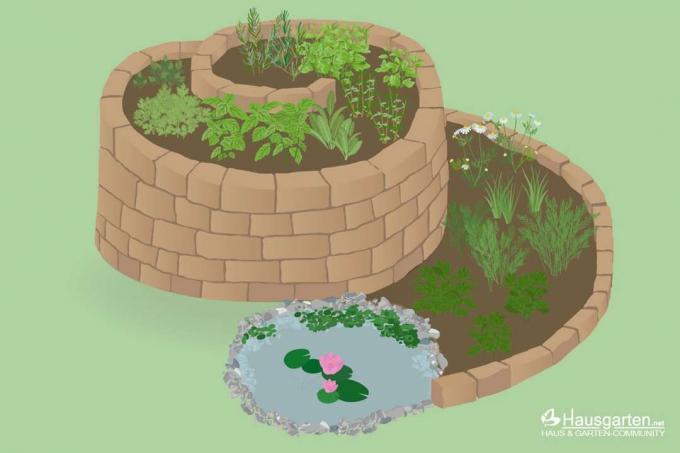

Table of contents
- herb selection
- location search
- Optimal size
- Simple garden bed
- raised bed
- herbal spiral
- Build a herb bed
- soil optimization
- Plant the herb bed
- time
- rules for planting
- Tips for arranging the herbs
For those who have developed a taste for herbs, the window sill will soon be too narrow. A real herb bed is needed. But just as the different types of herbs do not all taste the same, their needs can also vary widely. A guide.
herb selection
The choice of variety is the decisive point when planning and creating a herb bed. Because the cultivated herbs, as beautiful as they are to look at, should above all be useful. So first, make a list of all the herbs you want to use or try. Of course you can also choose one or the other herb simply because it is decorative. Get an overview of site and care requirements.
location search
The second step is to check whether your own garden offers a suitable location for the bed. Strongly scented types of herbs in particular need a lot of sun and warmth. The sunnier they are, the more essential oils they will produce. At the same time, they require a rather dry and nutrient-poor soil that does not tend to waterlogging. These include basil, savory, lavender, oregano, rosemary, sage, and thyme, among others. Wild garlic, dill, fennel, camomile, chervil, lovage, mint, parsley, chives and lemon balm prefer a semi-shady spot with humus-rich, nutrient-rich and slightly moist soil. A few herbs, such as watercress, like it particularly moist.
Optimal size

The bed should not be too big and should be accessible from all sides so that harvesting is effortless at all times. Sides of up to 1.2 m have proven to be ideal for rectangular beds. About three square meters are ideal for a well-stocked herb spiral. However, smaller spirals can also be erected on just one square meter. Then the number of plants must be reduced or excessive proliferation must be prevented by pruning measures.
Simple garden bed
- A low bed is the quickest and easiest to create
- with a border of wood, wicker fence, brick or stone
- possibly. also possible without a border
Tip:
If you want to cultivate many types of herbs with different location requirements, it is difficult to please everyone in a single bed. It may be worth creating two smaller herb beds in the ideal location.
raised bed
- Raised bed enables back-friendly work
- Ready-made kits make assembly easier
- inexpensive self-construction from leftover wood or pallets possible
- Herbs are harder for some pests to reach
herbal spiral
- a herb spiral, also called herb snail, looks decorative
- can be built of stones or bricks
- also rises
- allows different soil zones
- ideal for space-saving and optimal arrangement of herbs
- large stones store heat (ideal for Mediterranean plants)
Build a herb bed
It is best to set up the herb bed in autumn. Obtain appropriate instructions with all the detailed steps to ensure the construction is stable and lasts for many years. The side walls should be at least 5 cm above the ground so that it is not washed away by irrigation water or rain. Carefully layer natural stones on top of each other so that they cannot slip at any time. If you implement your own constructions, pay attention to materials that tolerate moisture and are not coated with any toxic paint or the like.
Tip:
In a garden where there are many voles, a fine-meshed wire fence should be worked horizontally into the ground at a sufficient depth and, if necessary, be connected to the construction. This is how you protect the roots of the herbal plants.
soil optimization
Tillage should also be tackled in the fall so that the soil can settle by spring. First, the garden bed is loosened up deeply, about 20 cm deep. Large stones and weed roots should be removed in the same operation. Ideally, raised beds and herb spirals should also be filled with soil in autumn.
At least two weeks before planting. Depending on the needs of the herbs, the soil is optimized with sand, compost and lime. Dry areas in the garden and raised bed need a drainage layer. A spiral of herbs winding upwards is divided into the following areas from top to bottom:
- dry area: 50% sand and garden soil or herbal soil
- moderate range: 30% sand, compost and garden or herbal soil, 10% lava granulate
- humid area: 50% each garden soil and compost
- Water area (optional): compost, possibly with garden soil
Tip:
A herb bed should last for many years. It is therefore worth carrying out a soil analysis before planting. In this way, the soil improvement can be carried out precisely with the required minerals.
Plant the herb bed

time
Start greening the herb bed in spring. You can use seeds, self-grown plants or larger commercial plants. In the latter case, the harvest can start earlier and is therefore more plentiful overall. Plants purchased should be vigorous, well-branched, with good root systems and foliage in good condition. Then you don't bring any pests or diseases into the bed. Annual herbs that are sensitive to frost may only be planted or dried after mid-May. be sown outside. Note the sowing conditions on the seed packet.
rules for planting
- Place the potted herbs in a water bath until the root ball is soaked
- Dig a sufficiently large planting hole
- Maintain planting depth
- Press the soil down well for good contact with the ground
- douse with a fine shower
Tip:
Before planting, you can spread a special weed fleece over the soil, into which you cut planting openings. Hardly any weeds will grow later. But the fleece does not replace winter protection measures for frost-sensitive herb species.
Tips for arranging the herbs
1. Herb species for dry areas in full sun
- mountain savory (Satureja montana)
- curry herb (Helichrysum italicum)
- Lavender Thyme (thymus thracicus)
- marjoram (Origanum majorana)
- oregano (Origanum vulgare)
- rosemary (Rosmarinus officinalis)
- sage (salvia)
- thyme (thymus vulgaris)
2. Herb species for the temperate area/partial shade
- basil (Ocimum basilicum)
- tarragon (Artemisia dracunculus)
- Spice Fennel (Foeniculum vulgare)
- Small burnet (Sanguisorba minor)
- coriander (Coriandrum sativum)
- lemon balm (Melissa officinalis)
- Parsely (Petroselinum crispum)
- burnet (Sanguisorba minor)
- chopped garlic (Allium tuberosum)
- chives (Allium schoenoprasum)
- hyssop (Hyssopus officinalis)
3. Types of herbs for the humid area
- wild garlic (Allium ursinum)
- borage (Borago officinalis)
- dill (Anethum graveolens)
- garden mint (Calamintha grandiflora)
- Nasturtium (Tropaeolum majus)
- chervil (Anthriscus cerefolium)
- sorrel (Rumex acetosa)
4. Types of herbs for the water zone
- stream exercise (Veronica beccabunga)
- watercress (Nasturtium officinale)
- calamus (Acorus gramineus)
- sedanina (Apium nodiflorum)
- water mint (Mentha aquatica)
- water chestnut (Trapa natans)
5. Do not put these herbs in the herb bed
It is better to plant herbs that are proliferating or exude inhibitors from their roots outside of the herb bed. These are among others these types:
- Comfrey (symphytum)
- spice laurel (Laurus nobilis)
- turmeric (Curcuma longa)
- lavender (Lavandula officinalis)
- Lovage, maggi herb (Levisticum officinale)
- Wormwood (Artemisia absinthium)
- Hyssop, vinegar herb (Hyssopus officinalis)
- lemongrass (Cymbopogon citratus)
Lavender likes to sit under a rose bush. Wormwood herb can be planted near currants because it keeps disease away from them.
6. Do not mix annuals and perennials
Be careful not to unnecessarily mix perennial and annual herbs when arranging them. The annual soil work that is necessary for annual plants is disruptive to the other herbs.

7. Pay attention to good neighbors
Some types of herbs have very similar requirements in terms of location and care, while others form a good symbiosis against pests or mutually promote growth. When arranging, plan for these good neighborhoods for a healthy bounty harvest:
- Mediterranean herbs among themselves
- Basil with oregano, parsley and rosemary
- Parsley with basil, dill, garden cress, chervil and chives
- Tarragon, lemon balm, sage, chives and thyme
- Oregano, sage and winter savory
8. Avoid unfavorable combinations
- Parsley: Borage, tarragon, chervil, coriander, lavender and peppermint
- Basil: Marjoram, Dill, Peppermint and Lemon Balm
- Chamomile and Peppermint
- Coriander: fennel, chervil and chives
- Thyme: marjoram and peppermint
- Wormwood: lemon balm, fennel and caraway
9. Place intensely fragrant herbs at the edge of the bed
In a simple herb bed or raised bed, you should place intensively scented herbs such as thyme, mint and oregano at the edge of the bed. Your essential oils will expel pests.
10. Pay attention to sufficient planting distance
Consider the size potential and also the growth rate of an herb. If the bed is very small, it is better to reduce the selection of herbs and rely on close planting. This prevents pests and diseases.
11. Plant marigolds in the bed
Find a sunny spot for the marigolds in the herb bed. It repels lice, harmful nematodes and other pests. Their flowers are also edible.
 garden editorial
garden editorial I write about everything that interests me in my garden.
Learn more about growing herbs

Basil has black dots: what to do?
Especially basil bought in a pot from the supermarket tends to quickly develop black dots or spots on the leaves. This article explains why this is and what helps against it.

14 kitchen herbs that you can really keep in the kitchen
Sometimes a herb garden is only possible on the windowsill. If you don't have your own garden bed, for example, or in the months when the frost freezes the coveted greenery outside. Our list provides an overview of which herbs like the kitchen location permanently.

Parsley turns yellow: Four tips against yellow leaves
If the leaves of the parsley suddenly turn yellow, the so-called parsley disease is usually behind it. This can have many causes. If the outbreak of the disease is to be prevented, only prevention helps. More about this here.

You can combine lavender with these 13 plants
Whether you use it in the kitchen, want to enjoy its fragrance or its beauty, lavender is a must in any garden. Well combined, it can strengthen other plants or protect them from pests. We present the best plant neighbors.

8 tips for cutting and harvesting herbs properly
Fresh herbs from the garden should not be missing in any kitchen. They are versatile, exude pleasant and spicy scents and are a treat for the eye with their pretty flowers. In the kitchen, they can easily replace artificial flavor enhancers.

Herb spiral & herb snail: this is how it's done
A herb spiral or herb snail makes it possible to plant many different varieties in a particularly decorative way. However, this is not the only advantage of these variants of the culture. You can find out how to create them here.



